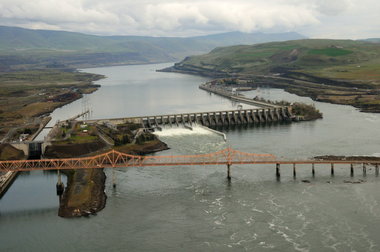forum
library
tutorial
contact

Poor Snowpack Could Shrink NW Hydropower
by Ted SickingerThe Oregonian, February 6, 2010
|
the film forum library tutorial contact |

|
Poor Snowpack Could Shrink NW Hydropower
by Ted SickingerThe Oregonian, February 6, 2010 |
 A thin snowpack and predictions of low runoff this summer have the Bonneville Power Administration forecasting a financial loss for the year, and Northwest water watchers hoping for more snowy weather before the winter's through.
A thin snowpack and predictions of low runoff this summer have the Bonneville Power Administration forecasting a financial loss for the year, and Northwest water watchers hoping for more snowy weather before the winter's through.
In a forecast issued Friday, the National Weather Service's Northwest River Forecast Center predicted that water flows past The Dalles Dam will be 79.2 million acre feet between January and July. That would be 74 percent of the 30-year average for the period -- 107.3 million acre feet -- and the eighth lowest flow in the past 40 years.
Anxiety levels remain fairly low. February and March can still be big snow months in the Columbia River Basin, filling the region's virtual reservoir. But the numbers have gotten progressively worse since the early bird forecast in December. As winter pushes on and the big snows fail to fly, the predictions begin to harden into reality.
Hydroelectric dams are the main source of electricity in the Northwest, providing about two-thirds of the region's generating capacity and about three quarters of its electric energy on average. Low runoff leaves dam managers balancing a host of competing priorities, from fish passage and navigation to flood control and irrigation.
Low summer flows through the turbines means less excess power available to serve California's seasonal demand, and can send utilities throughout the West scurrying into the wholesale market to buy power. Depending on the weather, economic conditions and industrial demand here and in California, that can have a domino effect, as it did during the 2001 energy crisis.
"The latest numbers are dry," Steve Barton, chief of the reservoir control center for the Army Corps of Engineers Northwestern Division, which manages the federal dams along with the Bureau of Reclamation. "We're still technically on a snow accumulation basis, but (recent) forecasts have shown a decline as we've continued to experience warmer and drier conditions."
The Columbia dams are so-called run-of-river hydroelectric projects, meaning they're dependent on natural flows from runoff, with limited storage capacity. Dam managers can keep more water behind the dams as flood control becomes less of a concern in later spring, but lesser flows typically mean tradeoffs between the competing interests.
Precipitation is expected to run 60 percent of normal for the month of February, said Tom Fero, a senior hydrologist at the River Forecast Center. While the upper reaches of the basin are doing better than southern, the region in general seems stuck in a dry pocket, he said, with most of the energy flowing south into California or north into Alaska.
Thank El Nino -- as warmer surface waters off the coast of South America bring drier and warmer winter weather to the Pacific Northwest. The Climate Prediction Center predicts that those conditions will prevail in the Northwest for the next 90 days.
What remains to be seen is how the remainder of spring plays out.
The Bonneville Power administration, which sells the power generated at 31 dams in the basin, is already preparing for a bad year due to an expected decline in sales of excess power into the wholesale market.
BPA forecast a $6 million loss for the fiscal year ending September 30 as part of its recent Quarterly Business Review. That's nearly a $240 million turnaround from its start-of-year-forecast.
"This is a very serious decline that impacts our power supply and therefore our finances," said BPA Administrator Steve Wright. "We're hopeful that the outlook will improve, but we cannot count on it."
BPA has financial reserves to fall back on, and just completed a rate case, so the revenue loss won't be immediately felt by BPA's public utility customers, said BPA spokesman Michael Milstein. If conditions continue to deteriorate, however, BPA does have a mechanism to reopen its rates.
Customers of investor-owned utilities could feel some of the heat. Portland General Electric, Oregon's largest utility, gets about a quarter of its power from hydro. Much of that is on contract, but the company has a substantial hydro fleet of its own that delivers cheap, fuel-free power.
The company declined to comment on operations in advance of its Feb. 25 earnings announcement. But if summer runoff is low, and the cost of replacement power is significant enough, some of it is passed directly to customers. PGE is already dependent on market purchases for much of its power, making its customers vulnerable to spikes in power prices.
Purely from the standpoint of utility costs, this is a relatively good year for a water shortage. As opposed to 2001, when low runoff, a heat wave and power shortages combined to create an energy crisis, the current recession means that demand is low, and power prices are reasonable.
"If you're going to have a year with bad runoff, this is the year to have it," said Bob Jenks, executive director of the Citizen's Utility Board of Oregon.
Then again, a lot will depend on summer weather throughout the West, he said. The lack of hydro could have significant impacts, "but it's too early to say whether it's likely to happen."
learn more on topics covered in the film
see the video
read the script
learn the songs
discussion forum
